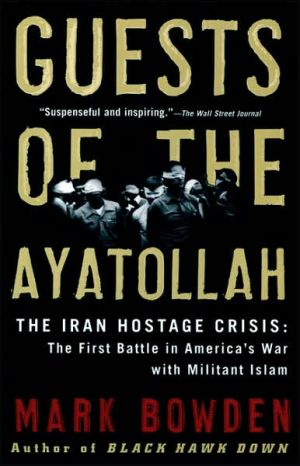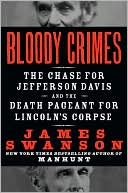Guests of the Ayatollah: The First Battle in America's War with Militant Islam
"The Iran hostage crisis was a watershed moment in American history. It was America's first showdown with Islamist fundamentalism, a confrontation that has remained at the forefront of American policy to this day: In Iran, following the ouster of the shah, a provisional government was established, and for a critical moment in the modern age's first Islamist revolution, a more open and democratic society seemed possible. But the religious hardliners on the Revolutionary Council used the...
Search in google:
From the best-selling author of Black Hawk Down comes a riveting, definitive chronicle of the Iran hostage crisis, America’s first battle with militant Islam. On November 4, 1979, a group of radical Islamist students, inspired by the revolutionary Iranian leader Ayatollah Khomeini, stormed the U.S. embassy in Tehran. They took fifty-two Americans hostage, and kept nearly all of them hostage for 444 days. In Guests of the Ayatollah, Mark Bowden tells this sweeping story through the eyes of the hostages, the soldiers in a new special forces unit sent to free them, their radical, naïve captors, and the diplomats working to end the crisis. Bowden takes us inside the hostages’ cells and inside the Oval Office for meetings with President Carter and his exhausted team. We travel to international capitals where shadowy figures held clandestine negotiations, and to the deserts of Iran, where a courageous, desperate attempt to rescue the hostages exploded into tragic failure. Bowden dedicated five years to this research, including numerous trips to Iran and countless interviews with those involved on both sides. Guests of the Ayatollah is a detailed, brilliantly re-created, and suspenseful account of a crisis that gripped and ultimately changed the world. The Washington Post - Afshin Molavi … Bowden skillfully evokes the era and the ordeal, putting a human face on the yellow ribbons. And he describes in detail President Carter's vacillations, the failed rescue attempts, and the charlatans and apologists who acted as private intermediaries to seek the hostages' release (and their own photo ops).
GUESTS OF THE AYATOLLAH\ THE FIRST BATTLE IN AMERICA'S WAR WITH MILITANT ISLAM \ \ By MARK BOWDEN \ Atlantic Monthly Press\ Copyright © 2006 Mark Bowden\ All right reserved.\ ISBN: 0-87113-925-1 \ \ \ Chapter One\ THE DESERT ANGEL \ Before dawn Mohammad Hashemi prepared himself to die. He washed according to ritual, then knelt in his dormitory room facing southwest toward Mecca, bent his head to the floor, and prayed the prayer for martyrdom. After that the stout, bushy-haired young man with the thick beard tucked a handgun in his belt, pulled on a heavy sweater, and set out through the half darkness for the secret meeting.\ It was, in Iran, the thirteenth day of Aban in the year 1358. The old Zoroastrian calendar had been resurrected a half century earlier by the first self-appointed shah in the Pahlavi line, Reza Khan, in an effort to graft his royal pretensions to the nation's ancient traditions. That flirtation with Persia's gods and bearded prophets had backfired, sprung up like an uncorked genie in the previous ten months to unseat his son and the whole presumptuous dynasty. Aban is Persia's old water spirit, a bringer of rebirth and renewal to desert lands, and the mist wetting the windows of high-rises and squeaking on the windshields of early traffic in this city of more than five million was a kept promise, an ancient visitation, the punctual return of a familiar and welcome angel. Asit crept downhill through the sprawling capital and across the gray campus of Amir Kabir University, where Hashemi hurried to his meeting, Iran was in tumult, in mid-revolution, caught in a struggle between present and past. Towering cranes posed like skeletal birds at irregular intervals over the city's low roofline, stiff sentinels at construction sites stranded in the violent shift of political climate. The fine rain gently blackened concrete and spotted dust in the canals called jubes on both sides of every street, fanning out like veins. Moisture haloed the glow from streetlamps.\ Hashemi was supposed to be a third-year physics major, but for him, as for so many of Tehran's students, the politics of the street had supplanted study. He hadn't been to a class since the uprising had begun more than a year ago. It was a heady time to be young in Iran, on the front lines of change. They felt as though they were shaping not only their own futures but the future of their country and the world. They had overthrown a tyrant. Destiny or, as Hashemi saw it, the will of Allah was guiding them. The word on campus was, "We dealt with the shah and the United States is next!"\ Few of the hundred or so converging from campuses all over the city on Amir Kabir's School of Mechanics that morning knew why they were gathering. Something big was planned, but just what was known only to activist leaders like Hashemi. Shortly after six, standing before an eager crowded room, he spread out on a long table sketches of the U.S. embassy, crude renderings of the mission's compound just a few blocks west. He and others had been scouting the target for more than a week, watching from the rooftops of tall buildings across the side streets, riding past on the upper floor of two-decker buses that rolled along Takht-e-Jamshid Avenue in front, and waiting in the long lines outside the embassy's newly opened consulate. The drawings showed the various gates, guard posts, and buildings, the largest being the chancery, the embassy's primary office building; the bunkerlike consulate; and the airy two-story white mansion that served as home for the American ambassador. There was a murmur of satisfaction and excitement in the crowd as Hashemi announced they were going to lay siege to the place.\ In retrospect, it was all too predictable. An operating American embassy in the heart of revolutionary Iran's capital was too much for Tehran's aroused citizenry to bear. It had to go. It was a symbol of everything the nascent upheaval hated and feared. Washington's underestimation of the danger was just part of a larger failure; it had not foreseen the gathering threat to its longtime Cold War ally Mohammad Reza Pahlavi, the now reviled, self-exiled shah. A CIA analysis in August 1978, just six months before Pahlavi fled Iran for good, had concluded that the country "is not in a revolutionary or even a prerevolutionary situation." A year and a revolution later America was still underestimating the power and vision of the mullahs behind it. Like most of the great turning points in history, it was obvious and yet no one saw it coming.\ The capture of the U.S. embassy in Tehran was a glimpse of something new and bewildering. It was the first battle in America's war against militant Islam, a conflict that would eventually engage much of the world. Iran's revolution wasn't just a localized power struggle; it had tapped a subterranean ocean of Islamist outrage. For half a century the tradition-bound peoples of the Middle and Near East, owning most of the world's oil resources, had been regarded as little more than valuable pawns in a worldwide competition between capitalist democracy and communist dictatorship. In the Arab states, the United States had thrown its weight behind conservative Sunni regimes, and in Iran behind Pahlavi, who stood as a bulwark against Soviet expansionism in the region. As the two great powers saw it, the Cold War would determine the shape of the world; all other perspectives, those from the so-called Third World, were irrelevant, or important only insofar as they influenced the primary struggle. An ignored but growing vision in the Middle East, nurtured in mosque and madrasah but considered quaint or backward by the Western world and even by many wealthy, well-educated Arabs and Persians, saw little difference between the great powers. Both were infidels, godless exploiters, uprooting centuries of tradition and trampling sacred ground in heedless pursuit of wealth and power. They were twin devils of modernity. The Islamist alternative they foresaw was an old twist on a familiar twentieth-century theme: totalitarianism rooted in divine revelation. It would take many years for the movement to be clearly seen, but the takeover of the embassy in Tehran offered an early glimpse. It was the first time America would hear itself called the "Great Satan."\ How and why did it happen? Who were the Iranian protesters who swarmed over the embassy walls that day, and what were they trying to accomplish? Who were the powers behind them, so heedless of age-old privileges of international diplomacy? What were their motives? Why was the United States so surprised by the event and so embarrassingly powerless to counter it? How justified were the Iranian fears that motivated it? How did one of the triumphs of Western freedom and technology; a truly global news media, become a tool to further an Islamo-fascist agenda, narrowly focusing the attention of the world on fifty-two helpless, captive diplomats, hijacking the policy agenda of America for more than a year, helping to bring down the presidency of Jimmy Carter, and leveraging a radical fundamentalist regime in Iran into lasting power?\ The U.S. embassy in Tehran stood behind high brick walls midway down the city's muscular slope, where the land flattened into miles of low brown slums and, beyond them, the horizon-wide Dasht-e Kavir salt desert. Inside the enclosure was a parklike campus, a twenty-seven-acre oasis of green in a smoggy world of concrete and brick. Its primary structure, the chancery, bathed now in the swirling mist of the water angel, stood fifty or so feet behind the front gate, a blocks-long structure two tall stories high built in the dignified art deco style typical of American public buildings at midcentury. It looked like a big American high school, which is why years ago it had been dubbed "Henderson High," after Loy W. Henderson, the first U.S. ambassador to use it, in the early fifties. Scattered beneath a grove of pine trees behind the chancery were the new concrete consulate buildings; the white Ambassador's Residence, a two-story structure with a wraparound second-story balcony; a smaller residence for the deputy chief of mission; a warehouse; a large commissary; a small office building and motor pool; and a row of four small yellow staff cottages. There were tennis courts, a swimming pool, and a satellite reception center.\ When the embassy opened more than four decades previously, Tehran had been a different place, more a village than a city. The United States was then just one among many foreign powers with diplomatic missions in Iran. Before the chancery stood a low, decorative wooden fence that allowed an unobstructed view of the beautiful gardens from Takht-e-Jamshid, which was then just a quiet side street, paved with cobblestones. In those days, the new embassy's openness and its distance from the row of major missions on busy Ferdowsi Avenue contributed to America's image as a different kind of Western power, one that had no imperial designs.\ In the years since, Tehran itself had grown into a noisy, crowded city, a bland, featureless, unplanned jumble of urgent humanity that flowed daily in great rivers of cars through uninteresting miles of low, pale brown and gray two- and three-story boxlike buildings. Takht-e-Jamshid's quaint cobblestones had long since been paved and the avenue widened. In daylight it was clogged with cars, motorbikes, and buses. The embassy's main entrance, Roosevelt Gate, was named after Franklin D. Roosevelt, whose distant cousin CIA officer Kermit Roosevelt, Theodore's grandson, had helped engineer the 1953 coup d'etat that toppled an elected Iranian government and replaced it with the shah. At the time, the coup had powerful Iranian backers and was welcomed by many in the country, but today it was seen simply as a tawdry American stunt, another example of cynical CIA meddling in the Third World.\ By the fall of 1979, in the receding tide of the revolution, the old embassy had become a provocation. It was moored like an enemy battleship just a stone's throw from the street, a fact demonstrated repeatedly. For a country in a fit of Islamist, nationalist, and increasingly anti-American fervor, such a grand and central presence in the capital city was a daily thumb in the eye. Lately most of the harassment had been relatively minor. The walls that now surrounded Henderson High and its campus were covered with insults and revolutionary slogans and were topped by three feet of curved and pointed steel bars. A few days earlier a band of young men had sneaked into the compound and were caught shinnying up the big pole in front of the chancery to take down the American flag. The marines had since greased the pole. As a defense against rocks and an occasional gunshot from passing motorists, all of the windows facing front had been layered with bulletproof plastic panels and sandbags. The chancery looked like a fort.\ While the Americans inside saw these changes as purely defensive, the picture they presented strongly encouraged suspicion. The embassy was an enemy foothold behind the lines of the revolution. Washington had been the muscle behind the shah's rule, and a big part of throwing off the monarchy had been the desire to break Iran's decades-long fealty to Uncle Sam. Yet here the embassy still stood. Those Iranians who supported the United States-and there were many still among the prosperous middle and upper classes-prayed that its obdurate presence meant the game wasn't over, that the free world was not really going to abandon them to the bearded clerics. But these were an embattled, endangered minority. To the great stirred mass of Iranians, afire with the dream of a perfect Islamist society, the embassy was a threat. Surely the architects of evil behind those walls were plotting day and night. What was going on inside? What plots were being hatched by the devils coming and going from its gates?\ Why was no one stopping them?\ Chapter Two\ WOULD THE MARINES SHOOT? \ A big demonstration was already in the works that morning, which had been proclaimed National Students Day, in honor of collegiate protesters who had been gunned down by the shah's police the year before. The numbers of those massacred had been wildly inflated, from a few score to "thousands," which played to Shia Islam's obsession with martyrdom. In addition to honoring the slain students, this rainy Sunday had also been declared an official day of mourning for more than forty pasdoran, Revolutionary Guards, who had been killed in a clash with Kurdish separatists the week before. There would be thousands of people in the streets. Hashemi and the others planned to launch their surprise from inside this larger crowd.\ Standing before a crowded room he explained that the assaulters would be divided into five groups, one for each of the embassy's larger buildings. The initial thrust would be through Roosevelt Gate. Local police would not interfere-their support had been quietly enlisted-but there was no telling what the Americans would do. If they opened fire, then the bodies of those martyred in the vanguard would be passed out to the crowd and carried aloft through the streets, sure to incite rage. When the planning session ended, the students drifted across town to the rallying point, the corner of Takht-e-Jamshid and Bahar Street, several blocks west of the embassy. Thousands had already begun to assemble in groups of twos and threes, in cars and on foot.\ The plan had been hatched by a dozen young Islamist activists, representatives from each of Tehran's major universities, who had formed just weeks before a group that called itself Muslim Students Following the Imam's Line, to differentiate itself from factions with agendas that varied from the teachings of Imam Ruhollah Khomeini. Hashemi was the son of an Isfahan cleric and had been raised in the devout traditions of Shia Islam. Unlike the city's other large universities, Amir Kabir was strictly Islamist. Classes were conducted as though teachers and students were together in a mosque, and prayer was a big part of every day and night. Robed women students did not speak to men other than family members unless the situation required it, such as working together in a lab. While Marxist and other leftist groups tended to dominate on the bigger, more secular campuses such as Tehran University, where the religious students were often still an unpopular minority, Amir Kabir was known as a center for Islamist radicals, young people strictly allied with Khomeini and the new mullah establishment.\ All men in the Islamic organizations called each other "brother," but Hashemi was part of a smaller, militant inner circle called the Brethren-"brothers who were more brothers than others," was how one would later explain it. Most of those recruited for the takeover effort were simply students, but the Brethren were something more. They would eventually form the nucleus of the new Iran's intelligence ministry. They were armed at all times and had connections with the powerful clergy and with high-ranking officials in the police and the provisional government who had sympathy for their political agenda. Hashemi had not been one of the instigators of the plot to seize the American embassy that day, but when those plans were formed he was naturally one of the first approached for help.\ (Continues...)\ \ \ \ \ Excerpted from GUESTS OF THE AYATOLLAH by MARK BOWDEN Copyright © 2006 by Mark Bowden. Excerpted by permission.\ All rights reserved. No part of this excerpt may be reproduced or reprinted without permission in writing from the publisher.\ Excerpts are provided by Dial-A-Book Inc. solely for the personal use of visitors to this web site. \ \
\ From Barnes & NobleOn November 4, 1979, scores of Iranian students scaled the walls of the U.S. embassy in Tehran, beginning a hostage crisis that would last 444 days and cost President Jimmy Carter his reelection. Twenty-five years later, this major event in American history seems both distant and oddly immediate. As Mark Bowden notes in this extraordinary book, the Iranian hostage crisis was America's first showdown with Islamic fundamentalism. The author of Black Hawk Down spent five years reconstructing the incident, re-creating it through the eyes of the terrified hostages and their radical, naïve captors. In Guests of the Ayatollah, he takes us into Oval Office consultations, exposes the startling truth behind October Surprise rumors, and tracks the fragile clandestine negotiations that led to the prisoner releases.\ \ \ \ \ Afshin Molavi… Bowden skillfully evokes the era and the ordeal, putting a human face on the yellow ribbons. And he describes in detail President Carter's vacillations, the failed rescue attempts, and the charlatans and apologists who acted as private intermediaries to seek the hostages' release (and their own photo ops).\ — The Washington Post\ \ \ Janet MaslinMr. Bowden reaffirms his role as tough-guy Cassandra with this hefty replay of the hostage crisis in Iran that began in 1979. Invoking Philip Roth's great aphorism about hindsight ("the terror of the unforeseen is what the science of history hides"), Mr. Bowden returns to that pivotal 444-day ordeal and reconstructs it with painstaking care.\ — The New York Times\ \ \ \ \ Publishers WeeklyBowden, whose Black Hawk Down won him a National Book Award nomination, turns his sights to the 1979 Iran hostage crisis. The audio abridgment is generally smooth, though it's often difficult to keep the cast of characters straight: 66 original hostages, dozens of Iranian captors and untold numbers of diplomats, bureaucrats and family members. On audio, such a dizzying array of stories and backstories can become confusing. Bowden is a capable and competent narrator; while there are no tour de force performances here, the reading is solid and consistent, with no annoying vocal tics or other distractions. The real bonus of the audio over the print version is the final disc, which contains several visual enhancements: a PDF map of the embassy compound; a map of Iran, with markings not only for cities but also the landing site of the ill-fated 1980 rescue mission; and, most impressively, almost nine minutes of footage from the Discovery Channel's four-part documentary Guests of the Ayatollah, featuring compelling interviews with surviving members of the rescue team. Simultaneous release with the Atlantic Monthly hardcover (Reviews, Apr. 17). (May) Copyright 2006 Reed Business Information.\ \ \ \ \ Library JournalAccording to his publisher, Bowden (Black Hawk Down) took five years to write this book. It wasn't long enough. His account of the Iran Hostage Crisis is overwritten, sloppy in detail, and seemingly endless. He begins with prose not unlike that of the pulp novels that Garrison Keillor's "Guy Noir" satirizes, and by the time his writing becomes less turgid the reader realizes with horror that there still remains an arduous 500-page slog ahead. Bowden faults the media for failing to explain Iranian hatred of America, but beyond the briefest description of the 1953 CIA-backed coup, he does no better-unlike David Harris in his excellent The Crisis: The President, The Prophet, and the Shah-1979 and the Coming of Militant Islam, a lucid and comprehensive exploration of the tensions in Iran. Already, there is a shelf of books on this topic, many by insiders such as the American charg , the leader of the failed rescue mission, and President Carter's chief of staff. The need for another book is unclear. Though it is a quarter-century old, Robert D. McFadden's No Hiding Place: The New York Times Inside Report on the Hostage Crisis is concise, readable, and far better. Not recommended. [See Prepub Alert, LJ 1/06.]-Michael O. Eshleman, Kings Mills, OH Copyright 2006 Reed Business Information.\ \ \ \ \ Kirkus ReviewsA riveting account of the 444-day Iran hostage crisis of 1979-81. Bowden's (Road Work, 2004, etc.) contention that the capture of the U.S. embassy in Tehran was "the first battle in America's war against militant Islam" needs qualification, for America had been battling by proxy for years. Still, it was the first direct assault on Americans in strength. Those who undertook it viewed the Cold War superpowers as equally evil-surprisingly, the so-called "Muslim Students Following the Imam's Line" had first planned to take over the Soviet embassy in Tehran-and wanted to guide their nation, freshly rid of the much-hated Shah and now governed by a conservative Islamic theocracy, away from Western modernism and toward some recapitulation of the medieval golden age. Led by an inner circle called The Brethren, the militants who stormed the embassy on Nov. 4, 1979, initially planned to stay for three days and broadcast their grievances; once it became apparent that the Ayatollah Khomeini's government was not going to eject them-and the attack, it seems, took most of the mullahs by surprise, too-they stayed on. Using the same you-are-there point of view as he did in Black Hawk Down (1999), Bowden introduces figures on both sides of the struggle: American staffers who revered Persian culture and spoke the language fluently; humorless bureaucrats; gung-ho Marine guards and hardcore Delta Force types; Islamic ideologues convinced-and not without cause-that all Americans in Iran worked for the CIA; real-life students who, after a year of hostage-keeping, came to regard the enterprise as a mistake and drifted away; and, least likable of all, the Tokyo Rose-like Iranian interpreter who to this day insistson the justice of her actions and of the Islamist cause. It's a big book not to put down, but Bowden's latest will tempt readers to keep turning the pages. Altogether excellent-and its revelations of back-channel diplomatic dealings are newsworthy. First printing of 200,000; $150,000 ad/promo\ \








